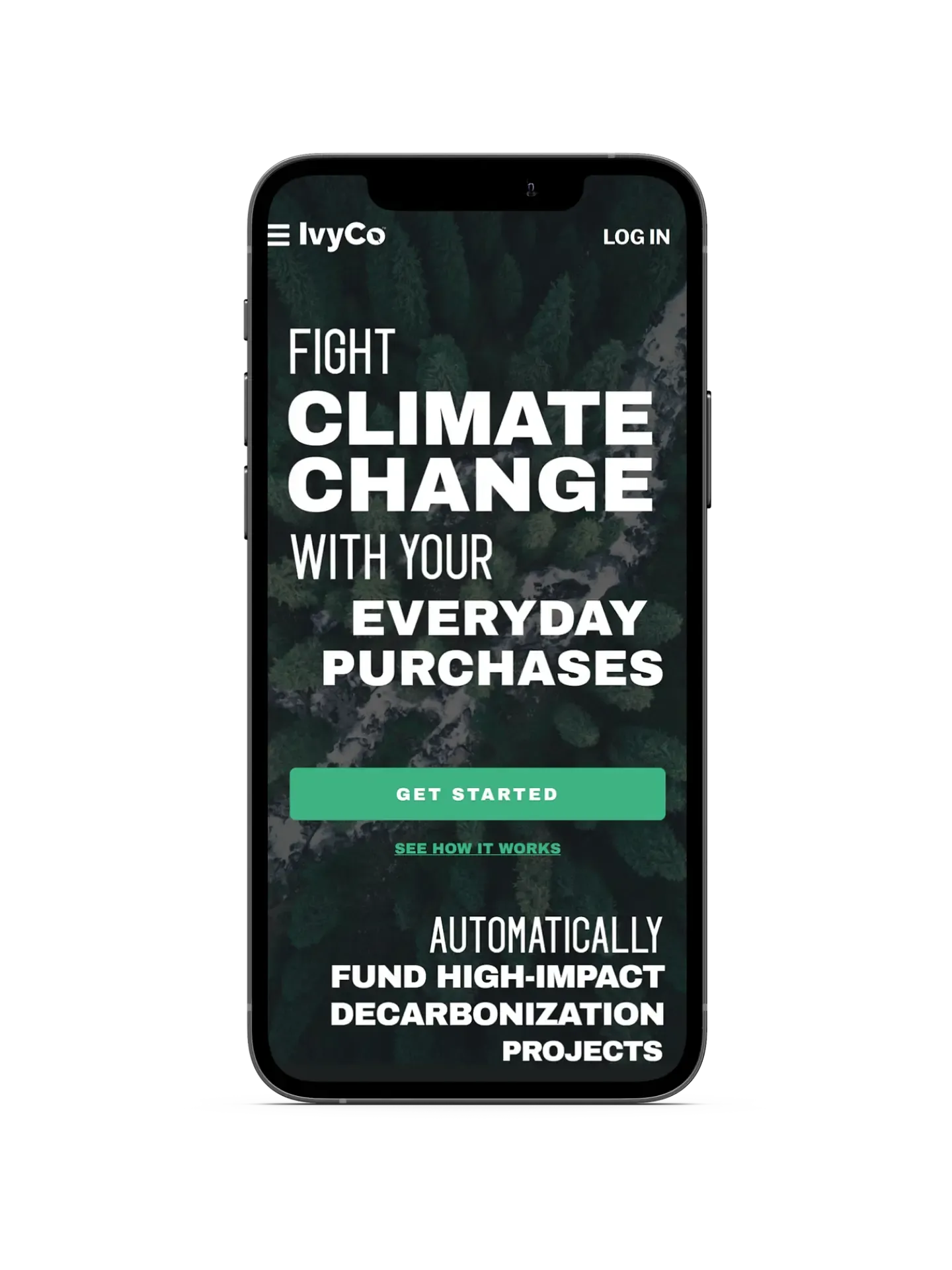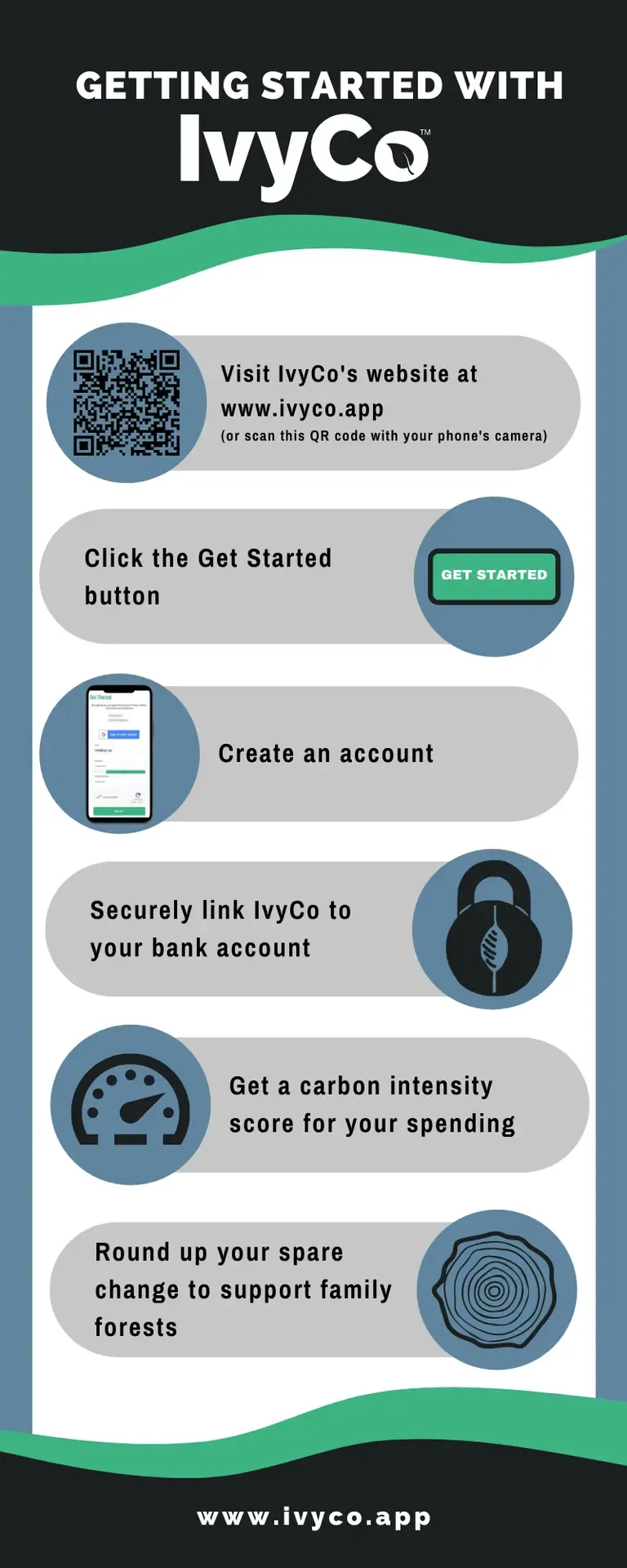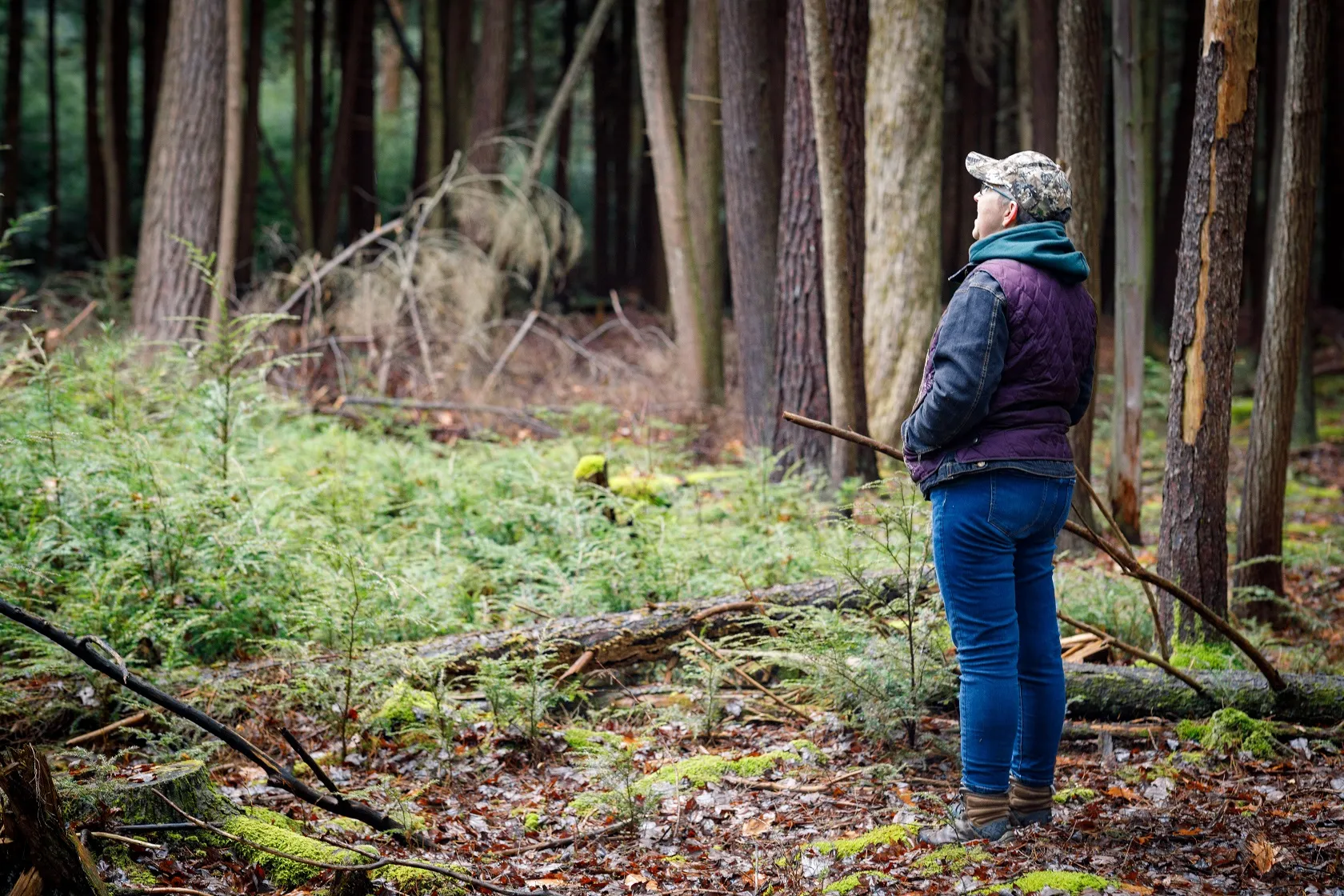Tackling Climate Change with Your Spare Change: A Collaborative Partnership with IvyCo
Sometimes the smallest of changes can make the biggest of differences, and in the case of a new American Forest Foundation (AFF) and IvyCo partnership, your spare change has the potential to improve family forests and make a dent in the fight against climate change.
AFF and IvyCo, a financial technology startup, recently launched an innovative collaboration to address the climate crisis by giving family forest owners and other individuals an easy-to-use tool not only to help family forests but to increase the potential of those forests as a critical natural climate solution.
IvyCo works to empower individuals to fight climate change with their everyday purchases. By connecting to an individual’s bank accounts through a secure, industry-leading open-banking technology – the same systems used by Venmo – IvyCo analyzes spending patterns to allow users to understand their largest areas of climate impact. The system not only educates about carbon-intensive spending but allows users to round up their spare change to fund decarbonization efforts through the Family Forest Carbon Program (FFCP), AFF’s existing partnership with The Nature Conservancy.
"The partnership with IvyCo is a great fit because our values align," said John Ringer, AFF market development manager. "It’s the first carbon program of this kind. Previously, carbon projects were limited to large tracts of land. This program makes it possible – for the first time – for family forests, which were generally too small to participate in the voluntary carbon marketplace, to take an active part in addressing climate issues by doing it collectively. And spare change helps make funding possible."
Using Pocket Money to Support Conservation Impact
The FFCP allows family forest owners to earn income from growing their forests and using sustainable forestry practices. Trees are sometimes called the lungs of the Earth because they absorb pollutants, including carbon dioxide, a greenhouse gas, by trapping (or "sequestering") and filtering the contaminants through their leaves. Increasing forest acreage allows trees to tap even more carbon, which can help address climate change through natural solutions, Ringer explained.
Forests currently help neutralize about 15% of the U.S.’ annual carbon emissions, and they have the potential to nearly double that with additional action, Ringer said. Because families and individuals own 36% of U.S. forests – the single largest share – family forests have the potential to mitigate as much as 80 million tons of carbon dioxide equivalent every year, equal to removing 18 million cars from the road or closing 20 coal-fired power plants.
"There’s growing awareness that trees and forestry are an incredibly important part of the solution to addressing climate change," Ringer said. "And it’s clear that individual and family-owned forests are the biggest opportunity for climate action as it pertains to forests. The partnership with IvyCo allows individuals to fund the climate-change mitigation efforts of the FFCP to help forests and the environment."

"There’s growing awareness that trees and forestry are an incredibly important part of the solution to addressing climate change," Ringer said. "And it’s clear that individual and family-owned forests are the biggest opportunity for climate action as it pertains to forests. The partnership with IvyCo allows individuals to fund the climate-change mitigation efforts of the FFCP to help forests and the environment."
This program makes it possible – for the first time for family forests, which were generally too small to participate in the voluntary carbon marketplace, to take an active part in addressing climate issues by doing it collectively. – John Ringer, Director of Carbon Market Development
IvyCo Founder and CEO Brian Alderman added, "Incredible climate benefits can be achieved through scaling IvyCo and AFF’s partnership. It’s a terrific fit in so many ways, including the scale. When you look at the relatively small acreage of an individual family forest and one person’s spare change, you can dismiss it as a drop of water in the ocean. But if you combine the acreage of all family forests and the spare change of millions, you can make a huge difference."
The program is a win-win for all participants, Ringer said. "The fact is that family forest owners love their land," he said. "We are simply providing them the resources – both technical and financial – for them to improve that land and hopefully help them pass it on to the next generation. The solution is in their hands. Our role is to support them."
Individuals and family forest owners participating in the FFCP program participate in a free carbon inventory carried out by AFF forest technicians. The results of the inventory determine the annual payment to each landowner, with viable projects generally earning from $20 to more than $100 per acre annually. "The FFCP money can be very important to a family forest owner from both a revenue and environmental standpoint," Ringer said.
For most family forest owners, the forest is not their main source of income, Ringer said. "But it costs to own land and sustain the land. FFCP solves for that," he explained. "It creates a source of revenue to cover the costs to steward the land. This way, owners aren’t forced into unsustainable or irresponsible harvesting or selling their land to developers because of a family medical emergency or a job loss. Our program helps with those cash flow problems and helps the environment at the same time."
Sustainable forestry efforts not only help in the climate effort, but they also support biodiversity, which is a big plus whether you are a hunter, a hiker or simply a lover of wildlife. "If you are a family forest owner, you’ve generally stewarded the land for years," Ringer said. "You love that land. You love it more than anyone else. These owners just need the tools to take sustainable forestry efforts further to support biodiversity and increase carbon sequestration. This program takes the small family forest off the sidelines and enables its owners to be part of the climate conversation and the climate solution. Importantly, the program is not about mandates or telling owners what they cannot do with their land. It shows you what you can voluntarily do to improve land you already love."
The FFCP is unique in the voluntary carbon marketplace because it focuses on small landholders, just as IvyCo focuses on individuals, IvyCo’s Alderman added. FFCP uses an innovative methodology to make it viable to produce carbon credits from small landholdings (40 acres vs. the usual thousands of acres for other forestry carbon credit programs), much like how IvyCo deploys an innovative methodology to enable Individuals to participate based on their own spending. Individuals and family forest owners together create a meaningful climate solution that helps all involved achieve their climate goals, he said.

How Does it Work
The process of getting started is simple. Just go to IvyCo’s website and click the Get Started button, which guides you through setting up an account. The account links to your bank account, using a secure banking technology, known as Plaid, which protects and encrypts all data. IvyCo never sees your bank login information, but connecting an account lets IvyCo automatically analyze transactions based on broad categories to determine the carbon intensity of your purchases. You then get a carbon-intensity score for each category, based on the transaction’s impact on climate and the dollar amount you spend.
For example, gasoline purchases are one of the highest-carbon-impact categories and might score an eight on the intensity scale, while going out to dinner would have a smaller score, he said. "The first step is education," Alderman said. "This will help you understand where your personal spending has the biggest impacts on climate."
Alderman acknowledged that the program is "not an exact science. We have a category for airlines, but we don’t know how far you flew. We have a grocery category, but we don’t if you are on a plant-based diet," which would have a lower carbon-intensity than a diet that includes meat. "We go with an average, but this still allows you to understand your own score and how it moves over time," he said.
The final step is rounding up your spare change to support the Family Forest Carbon Program. After a special analysis, IvyCo knows how much to round up your transactions based on carbon intensity. Again, in the gasoline example, you may spend $22.50 to fill the tank; the system may round up to $25 because of the higher carbon intensity of that transaction, he explained. In this example, you’d contribute $2.50 to support family forests.
It Costs Less than Netflix to Support Family Forests
Over a month, the average user’s roundups total $10.83, "less than your Netflix bill, but supporting around an acre of family-owned forests," Alderman said. The technology allows constant feedback, allowing you to filter based on a month or year, he noted. "Importantly, you are always in control," Alderman said, adding that you may cap contributions monthly and keep an eye on your overall spend.
"It’s piggy bank money that you don’t even think about," Alderman added. "The technology is safe and secure. After a year or a few years, you are going to see that you supported X acres of family forests through sustainable forestry practices. That’s a good feeling."
Simply understanding and then altering your spending patterns – even by a small amount – can "influence the world," he said. "Where you choose to spend your money influences company and government action. If you prioritize reducing your climate intensity – and other family forest owners and individuals do the same – companies and governments will listen and make changes as well."
The local nature of the program also makes it appealing to many, Alderman said. "I think for many of us, it’s much more real to contribute to [protecting climate] by focusing on American forests, as opposed to something like sending money to plant a tree in Brazil," Alderman said. "These are forest areas that we have visited. They are right here in America. Many of us have a tangible and quality connection to these forests, and we want to see them protected and thrive. It’s hard to visualize your $10.83 of spare change each month saving the Amazon rainforest. It’s a lot easier to see how that same amount could significantly impact a family forest."
If 100,000 Americans used IvyCo to round up just $10 per month-equivalent to just 0.17% of median household income – it would enable adding 1 million acres of family forest land to the FFCP per year. That’s an area a bit larger than Rhode Island.
The results of the inventory determine the annual payment to each landowner with viable projects generally earning from $20 to more than $100 per acre annually.
Early and sustained funding through the IvyCo platform helps carbon projects like the FFCP grow faster and lead to even more significant climate impacts, Ringer said. The aggregated contributions of IvyCo users are structured to remain in the FFCP program for up to five years before resulting in verified carbon credits, which enables the FFCP to use the funding to amplify impact many times over, Ringer added. The unique ability of individual consumers to fund the early development of the FFCP helps ensure its success not only for the carbon credits produced from the IvyCo contributions but also for the larger corporate carbon marketplace.
Giving Individuals the Confidence to Make a Difference
The voluntary carbon market allows businesses – and sometimes investors, governments and organizations – to voluntarily purchase carbon credits to mitigate their impact on global climate change. Many companies have corporate social and environmental responsibility goals that include lowering their climate impacts. After the company has reduced all their unavoidable emissions, it can purchase carbon credits from a verified carbon project. The credit is a tradable permit or certificate that neutralizes one ton of carbon dioxide (or the equivalent of another greenhouse gas). The money the company pays for the credit is used to finance carbon-reduction projects.
Even at the corporate level, finding ways to buy carbon credits of high integrity and quality can be challenging. At an individual level, it can seem impossible, Ringer said. "This partnership with IvyCo helps tackle that issue," he said. "Some people may want to try out the voluntary carbon market but may ask if the carbon credits they are purchasing are actually funding projects doing what they say they are doing. How do I know if it’s a quality program or that real, measurable climate action, is occurring?"
By dedicating funds to the FFCP, individuals have certainty that their money is making a difference because that revenue going to the sustainability efforts of the individual and family forest owners. The FCCP verifies that the actions the landowners take to sequester carbon, and it measures the amount of carbon trapped. "The FCCP is really top of the line," he said. "There’s a true focus on quality, and it takes an innovative and rigorous approach. You can know that the credits you are buying are verified."
Join today and encourage your friends and family members that care about family forests to do so as well. Together we can make a difference. Visit ivyco.app and get started.
Related Articles

December 16, 2025
Family Forest Carbon Program's First Ever Credits Delivered to REI Co-op
Today, REI becomes the first buyer to receive carbon credits from the Family Forest Carbon Program (FFCP), a high-integrity forest carbon project designed for small-acreage landowners.

December 4, 2025
Forest Carbon Project Issued First Ever Credits
Conservation organizations the American Forest Foundation (AFF) and The Nature Conservancy (TNC) announced today the issuance of improved forest management (IFM) carbon credits to the Family Forest Carbon Program (FFCP) from standards setter Verra under its Verified Carbon Standard (VCS) Program. This marks the first issuance of credits produced using Verra’s VM0045 improved forest management (IFM) methodology, which was co-developed by Verra, AFF, TNC, and TerraCarbon.

December 1, 2025
Tackling Wildfire Through Partnership: AFF’s Stacked Benefits Model
A few miles outside Grass Valley, California, a narrow road winds past homes tucked into dense forest. From the ground, it is easy to forget that these trees are doing something extraordinary. They are standing between the community and the next wildfire.